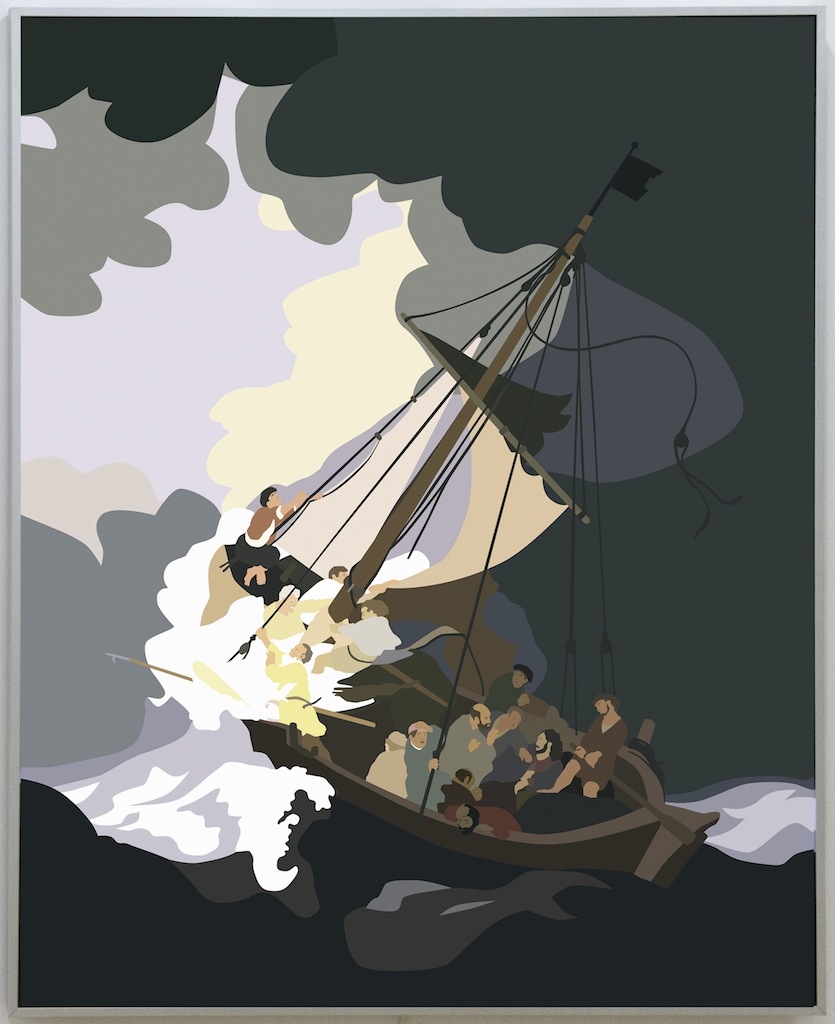It starts after midnight. 00:47 to be exact. 17 March 1990. The security camera footage shows a man in a trenchcoat walking into a building. Camera 2 is directed at the street outside where a car awaits, its lights on. Six minutes later, the man in the trench gets into the car, which leaves the frame.
The footage is from a video released by the FBI in August 2015 of the feed from the CCTVs at the Isabella Stewart Gardner Museum one night before the biggest art heist in history. On 18 March, two men disguised as Boston policemen coaxed a nighttime museum guard into letting them into the building and later left with 13 artworks estimated to be worth upwards of $500 million. The FBI released the video with the hope that members of the public would recognise the suspect from the night before.
In his show Thirteen Stolen Works of Art and a Videotape, Kota Ezawa recreates not only the security footage but also the stolen artworks. The footage is presented as a six-minute animation, looped on two screens. Ezawa uses the same software to make digitised renderings of the stolen masterpieces, which are presented in lightboxes, as he does to animate the video. The aesthetic is highly stylised. For example, a car is simplified into a box with two lights in its front, a Manet looks like a completed colour-by-numbers sheet, the Vermeer a scene from South Park. The video looks half-noir, half-Pink Panther. The images are recognisable, their relation to the original material plain to see, but they communicate a generic nature because of the repetition of style.
One of the reasons the Gardner theft remains so present is that the museum’s bylaws stipulate that no work may be removed from display. Since the thieves cut the canvases out of their frames, the latter remain hanging on their walls in Boston. The absence of Vermeer’s The Concert (1658–60), the five Degas drawings, the Manet portrait, the three Rembrandts is now institutionalised. Ezawa’s digital versions are proxies of works that are now part of some incidental conceptual gambit. Yes, they may not be the real thing, but they give presence to this absence. Is Ezawa relying too heavily on the history that informs this project? Possibly, but the story is enough for him to create a memorable statement on the circulation of images.
Only, Ezawa’s practice has not changed much with the development of imaging technologies. His past works are similar, digital renderings made of recognisable videos (the JFK, shooting, John Lennon and Yoko Ono’s ‘Bed-in’ for peace) and photographs (by photographers from Nan Goldin to Ansel Adams in the project The History of Photography Remix, 2004–06). In all, the aesthetic remains the same: highly stylised, simplified images not much informed by current thinking about the effect of Google Images on circulation, or the way that Photoshop has changed how we think about photography’s documentary status. Ezawa’s work reflects a very different strand of thinking about image circulation, one that is about the gap between how we remember an image and what it really was. The original is never shown next to his transformed version: there’s no need for it. It’s already presumed to be there in the viewer’s mind.
Ezawa refers to his process as ‘image theft’, but it’s not exactly that. Though he appropriates existing material, be it video footage, paintings or classic photography, the transformations wrought by his work make the latter appear at once suspicious and inconspicuous, like they belong on television and not as objects unto themselves. Maybe that’s the only way we’d like to experience events like the O. J. Simpson trial, the JFK murder or the Gardner heist: as fiction, not reality.
30 October – 9 December 2015, Murray Guy, New York
This article was first published in the January & February 2016 issue of ArtReview.
